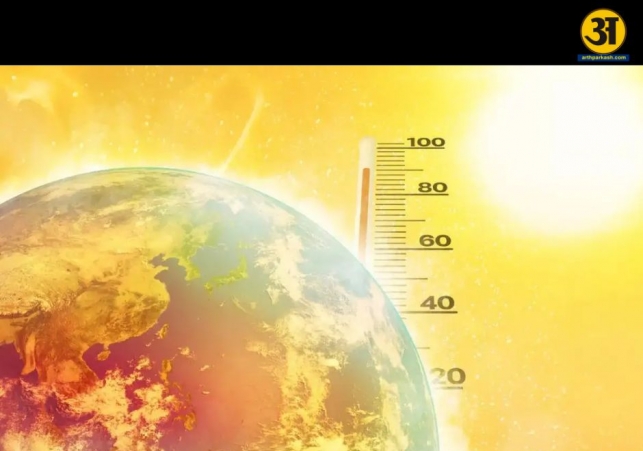

A new report by the World Meteorological Organization (WMO) warns that the next five years could be even hotter than before. The report says there is an 80% chance that a year between 2025 and 2029 will be hotter than 2024, which was already the hottest year ever recorded. There is also an 86% chance that at least one of those years will go above 1.5°C of warming compared to the pre-industrial period (before the late 1800s). Scientists say that passing this 1.5°C limit, even for a short time, will cause many problems for people and the environment.
This 1.5°C limit is very important because it was agreed upon in the Paris Agreement to reduce the harmful effects of climate change. Even though a single year going above this level does not mean the world has permanently crossed the threshold, WMO warns that such events will happen more often as the Earth keeps getting hotter.
The WMO report, titled “Global Annual to Decadal Climate Update (2025–2029)”, shows no signs of improvement. In fact, the chances of crossing 1.5°C in the next five years are increasing every year. Last year, the chance was 47% for the 2024–2028 period. The year before that, it was just 32% for 2023–2027. Now, the WMO says there is a 70% chance that the average global temperature between 2025 and 2029 will be more than 1.5°C higher than the average temperature from 1850 to 1900.
The report also says that the annual global temperature between 2025 and 2029 could be 1.2°C to 1.9°C higher than the pre-industrial average. These rising temperatures are expected to cause more heatwaves, droughts, heavy rainfall, storms, and other extreme weather events.
The Paris Agreement’s target of limiting warming to 1.5°C is meant to apply to long-term averages, typically over 20 years. But even short-term or temporary spikes above this level are worrying. They show that the planet is heading toward a more dangerous climate.
The report explains how each small rise in temperature can cause major damage. More warming means more intense heatwaves, stronger droughts, heavier rainfall, melting glaciers and polar ice, warmer oceans, and rising sea levels. These changes are harmful to people, animals, and the natural environment.
WMO’s Deputy Secretary-General Ko Barrett said that the world’s ten hottest years on record have all occurred recently. “The report gives no hope of relief,” Barrett said. “This means growing damage to our lives, economies, and the planet.” She added that we must keep tracking climate changes so that governments and others can make smart decisions and prepare for what’s coming.
ALSO READ: T'gana govt procured 64.5 lakh tons of Paddy during Rabi season: CM
The Arctic, which is already heating up faster than other parts of the world, is likely to warm over three and a half times the global average in the next five winters (November to March). According to the report, the Arctic could be 2.4°C warmer than its average temperature between 1991 and 2020. Sea ice in the Arctic Ocean will continue to shrink, especially in areas like the Barents Sea, Bering Sea, and Sea of Okhotsk during March 2025–2029.
The WMO also talked about expected changes in rainfall around the world. Between May and September in the years 2025 to 2029, areas such as the Sahel (in Africa), northern Europe, Alaska, and northern Siberia are likely to be wetter than usual. Meanwhile, the Amazon region could become drier. These changes in rainfall can affect farming, water supplies, and the health of forests.
South Asia has been experiencing more rainfall than usual in recent years, except for 2023. The WMO forecast suggests this trend will mostly continue between 2025 and 2029, although not every season may be wetter. This means that farmers and planners in South Asia should prepare for more frequent rainfall in the near future.
Ko Barrett stressed that the continued monitoring of the climate is necessary. Without proper data and forecasts, it would be very difficult for countries to respond to climate threats. She said that science-based tools are essential for governments to protect people and nature from the effects of global warming.
Earlier in March 2025, scientists from the European Union’s Copernicus Climate Change Service also issued a warning. They said that the world might cross the 1.5°C limit as early as September 2029 if current trends continue. This prediction moves the danger timeline closer. Previously, most experts thought the world might cross the 1.5°C line in the early 2030s.
The Copernicus scientists added that every new temperature record makes it harder to stop global warming. The longer the world takes to cut carbon emissions, the more difficult it becomes to stay below dangerous temperature limits.
Climate change experts are calling on all countries to take stronger steps to cut greenhouse gases like carbon dioxide and methane. These gases are mainly released by burning fossil fuels like coal, oil, and gas. Unless we reduce these emissions quickly, global warming will continue and cause more disasters.
The WMO report is another clear sign that time is running out. If action is not taken now, more people will suffer from heatwaves, floods, storms, wildfires, and rising sea levels. Plants, animals, and ecosystems will also face serious threats.
The message is clear: the world must act faster and more seriously to tackle climate change. Scientists are doing their job by warning us. Now it’s up to governments, businesses, and people everywhere to listen and act.